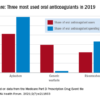“I use anticoagulants in high-risk PCI [percutaneous coronary intervention] patients with atrial fibrillation, and I expect to use more direct factor Xa inhibitor anticoagulants in light of the COMPASS findings, so having an agent that works for reversal – and these are very promising results – will be very important in our armamentarium. It will give us a safety net,” commented Ajay J. Kirtane, MD, director of the cardiac catheterization laboratory at Columbia University Medical Center in New York. (The COMPASS results, also presented at ACC 18, showed that peripheral artery disease patients on rivaroxaban plus aspirin had significantly fewer adverse peripheral vascular outcomes.)
The Prospective, Open-Label Study of Andexanet Alfa in Patients Receiving a Factor Xa Inhibitor Who Have Acute Major Bleeding (ANNEXA-4) enrolled 227 patients at any of 60 centers, with efficacy data available from 132 of the patients. About 60% of the patients had an intracranial bleed, and about 30% had a gastrointestinal bleed, and their average age was 77 years. Roughly three-quarters of patients were on an anticoagulant for atrial fibrillation, with the rest treated for venous thromboembolism, with 4% having both conditions. The most commonly used direct factor Xa inhbitors in these patients were apixaban (Eliquis) in 105 and rivaroxaban (Xarelto) in 75. The ANNEXA-4 study has not enrolled patients treated with a direct factor Xa inhibitor anticoagulant and undergoing surgery, a setting that will be the subject of a future study, Dr. Connolly said.
Idarucizumab reversed dabigatran completely and rapidly in study
Clinicians administered andexanet alfa as a bolus followed by a 2-hour continuous infusion, with hemostatic efficacy assessed 12 hours after the start of treatment. The results showed that factor Xa inhibition fell by about 75%-90% within minutes of starting the bolus and remained depressed at that level during the infusion but then began recovering by 2 hours after the stop of infusion. Andexanet is a factor Xa “decoy” molecule that acts by latching onto the inhibitor molecules and thereby preventing them from interacting with actual factor Xa, but andexanet also has a short half life and hence the effect quickly reduces once treatment stops.
“There is no doubt that andexanet rapidly decreases anti–factor Xa activity,” he said.
© Frontline Medical Communications 2018-2021. Reprinted with permission, all rights reserved.



